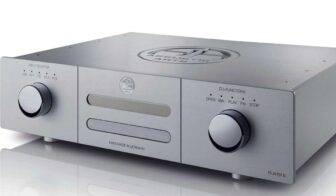Arcam Radia CD5 Review
It’s fun again to listen to good old CDs. One of the reasons for this is the new Arcam Radia CD5. What do we mean by that exactly? Read our test review to find out.
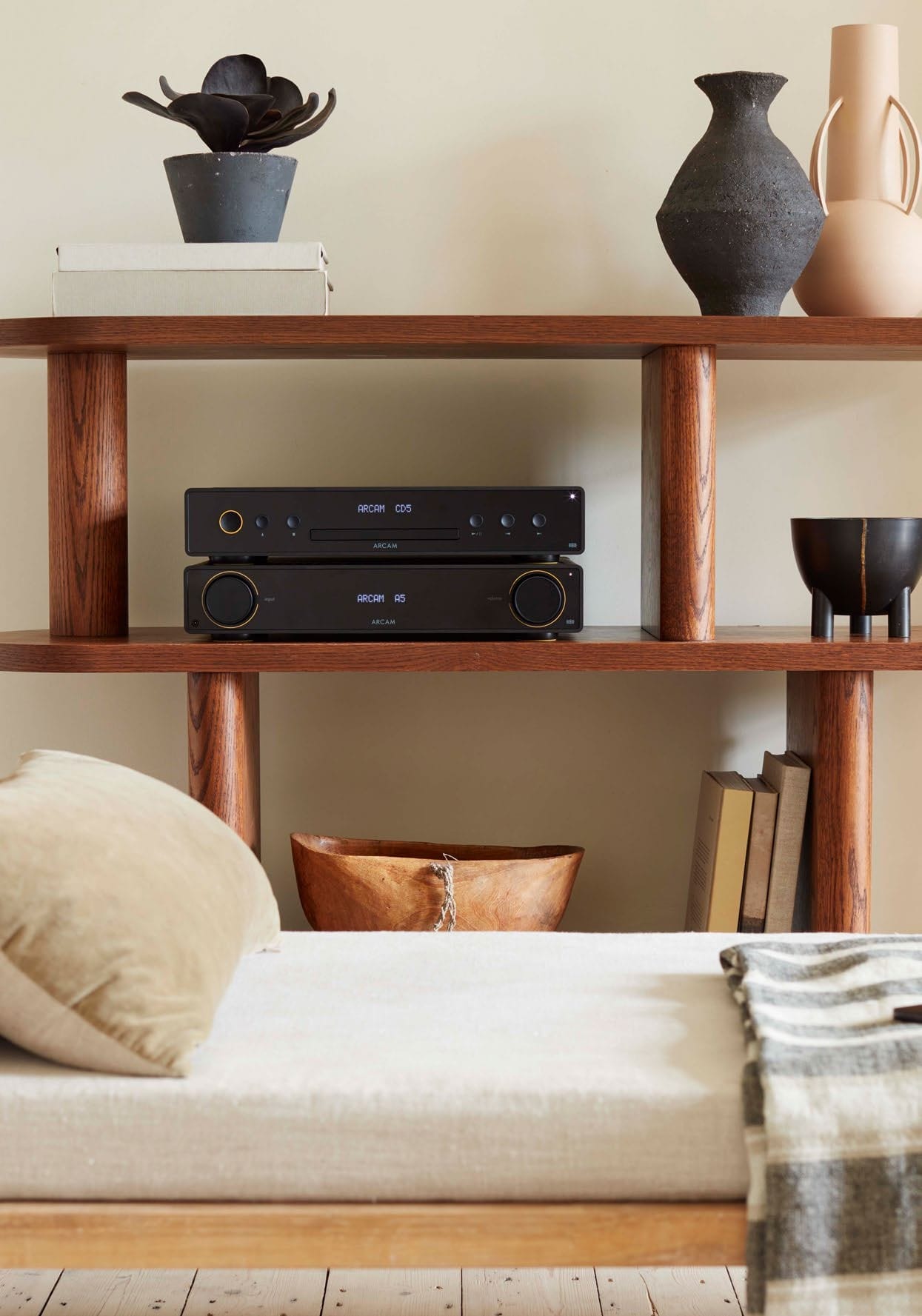
I remember very well sitting as a child in front of the TV, where tech experts explained why CDs were so great and much better than vinyl. CDs were scratched or even boiled in water. Then, when played, they worked flawlessly, proving that even scratched and boiled (!) CDs could still play music without issues.
Experts told us why a CD was superior: no noise, no wear, fast track skipping, long playtime without flipping, easy handling, compact size, and so on. The Compact Disc seemed like the holy grail. And for a long time, nothing could challenge its reign. It dominated the music market. Then came the MP3, MP3 players, illegal music-sharing sites, and finally, music streaming. At the same time, vinyl made a surprising comeback, and the CD seemed to fade into the background. But just like vinyl, the CD proved to be more resilient than expected.
No surprise, as CDs give you physical ownership of music. With streaming, your favorite album can simply disappear from the service’s catalog. More people are becoming aware of this fact. Enter the new Arcam Radia CD player. If you spend 20 euros on a new CD album – the equivalent of two months of streaming millions of albums – you want to enjoy it in the best possible quality.
A Long Tradition
When we think about the history of the CD player, we think of Philips and Sony, which developed the Audio Compact Disc to store digital audio data. This new medium was introduced in 1979.
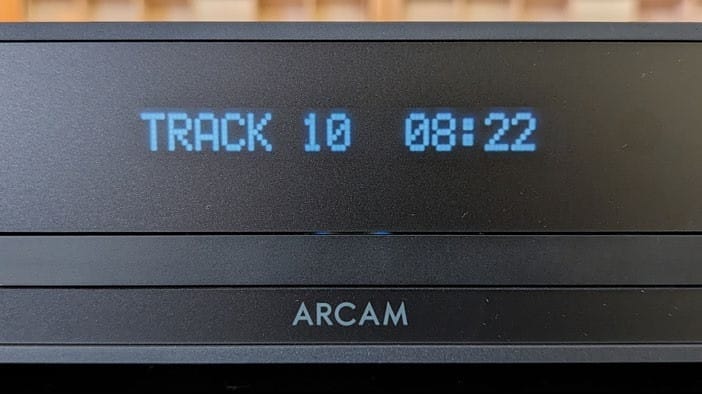
The British HiFi brand Arcam has always embraced new audio technologies, so naturally, they wanted to launch their own CD player. That led to the development of the Arcam Delta 70 CD player. Along with the Arcam Delta 90 amplifier, Arcam Delta 80 AM/FM tuner, and a range of Arcam speakers, the Delta 70 formed the first fully CD-based HiFi system designed and manufactured in the UK.
It’s important to note that most specialized HiFi companies at the time would simply rebrand mass-produced items and make slight modifications. But Arcam (A&R Cambridge Limited) wanted more. They sought to create a CD player that met the high standards of an Arcam product. To do so, they acquired a full CD manufacturing license to build the Delta 70 to their own high mechanical and electronic standards.
As a result, the Delta 70 was launched in 1987, costing a hefty £650 – approximately 2,000 DM at the time. But it was worth it: not only did the Delta sound better than most other CD players, but it was also more visually appealing and user-friendly.
Technically, the Arcam Delta 70 was quite advanced, utilizing a TDA1541 digital-to-analog converter with 16-bit resolution and 4x oversampling. It had a frequency response of 20 Hz to 20 kHz, a dynamic range of 96 dB, a signal-to-noise ratio of 105 dB, and channel separation of 100 dB. Total harmonic distortion was just 0.007%.

Arcam has since accumulated a wealth of experience with CD players, and all of that has been poured into the new Radia CD5.
Design
It’s clear that the Radia series is Arcam’s most visually appealing product line. This is partly due to its understated design and partly due to the small, subtle yellow accents on certain control elements. On the CD5, we find these accents, like on other Radia devices, along the sides and encircling the power button.
The display is cleverly designed as well. When the device is off, the display is completely hidden behind the matte front panel. Only when the device is powered on does the black-and-white display become visible. And if you’d rather not see it even when it’s on, you can simply press the backlight button on the remote to turn the display off.
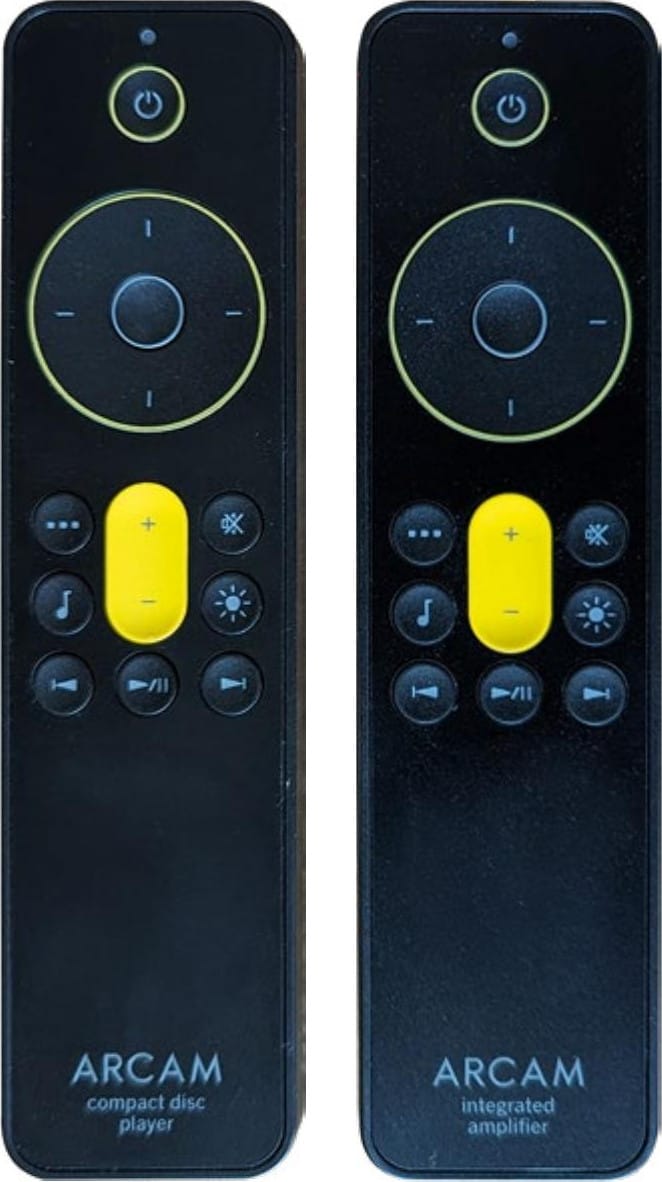
The five buttons on the front of the CD player are also elegantly integrated, with a slight curve that blends seamlessly into the device. The white LED in the top-right corner indicates when the CD5 is operational.
Operation
The Arcam Radia CD5 can be controlled in two ways: directly via the buttons on the front – stop, pause/play, track skip forward/back, and eject – or with the included remote. The remote looks exactly like the one for the Radia amplifier or streamer, so it might get confusing if you own all three devices. Only a small label at the bottom of the remote identifies it as the one for the CD player – so you might need your reading glasses!
With the IR remote, you can access additional functions, such as switching between repeat and shuffle modes by pressing the center button on the directional pad. The left and right buttons allow you to select the source. Source? Yes, besides playing CDs, the CD5 can also play music from a connected USB drive. Additionally, you can set the DAC filter of the player with the dots button. There are three options: “Slow,” “Phase,” and “Fast.” There’s also a power switch on the back to fully disconnect the device from the mains.
Connections
Speaking of the back, you’ll find three outputs and one input. The outputs include an optical digital output, a coaxial digital output, and an analog RCA output for connecting the CD player to an amplifier. The input is a USB-A port, allowing you to connect a mass storage device (e.g., USB stick) with WAV, FLAC, MP3, or AAC files for playback.
Technology
Inside, the CD5 uses an ESS ES9018 DAC chip. It’s configured to support WAV, FLAC, MP3, and AAC formats, with sample rates of 32, 44.1, 48, 88.2, and 96 kHz, with either 16 or 24-bit depth. 24-bit/96 kHz should suffice for most downloaded music files. If you need more, the Radia ST5 streamer supports up to 192 kHz. One fascinating feature of this DAC chip, or rather the CD5, is the three filters mentioned earlier.
During our listening test, the “Slow” and “Phase” filters were more forgiving with material, while the “Fast” filter exposed recording or mixing flaws. To put it another way: “Slow” and “Phase” sound softer, while “Fast” is a bit more clinical. However, these changes are minimal and only noticeable during close listening or comparison tests.
The signal-to-noise ratio of the Arcam Radia CD5 is 115 dB for 24-bit audio files and 93 dB for 16-bit files. Like its predecessor from the 1980s, the Radia CD player has a frequency range of 20 Hz to 20 kHz. Power consumption is 12 watts in operation and less than 0.5 watts in standby mode.

The time it takes for the CD5 to read a disc is around 10 seconds, a very good result comparable to other high-quality CD players. The time from pressing the eject button to the disc tray opening is 5 seconds, another excellent result.
One minor annoyance is the display, which always shows the total track time and counts down during playback. We would have liked the option to change the display to show how long the track has been playing.
What we do appreciate is how quiet the CD5 is during playback. Even when standing right next to it, the sound of the spinning disc is barely audible. At about half a meter away, in a quiet room, there’s no sound from the drive at all.
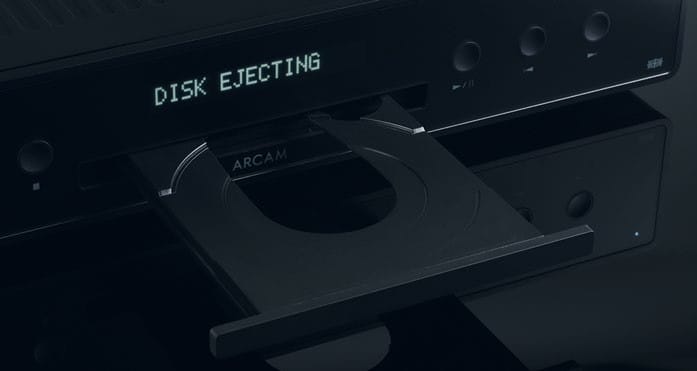
Sound Test
We connected the CD5 to its bigger sibling, the Radia A25 amplifier, and paired it with the Bowers & Wilkins 702 S3 Signature floor-standing speakers that we reviewed. We played music through both the digital (coaxial) and analog (RCA) connections. The digital connection provided a highly precise and detailed sound, while the analog connection softened the sound slightly, adding a bit more depth.
We found that this softer, deeper sound was more suitable for the Arcam Radia A25, which already excels in delivering fine details. We confirmed this by connecting the CD5 to the Musical Fidelity M8xi amplifier, where the results were the same: digital was more analytical, while analog was warmer and deeper. This impressed us, as it demonstrated that the Radia CD5 performs excellent digital-to-analog conversion, delivering the analog signal with heart and energy to the amplifier. Interestingly, we found ourselves listening to Gregorian chants – something we don’t usually do.
With the focus on human voices, which our ears and brains are most attuned to, it was the ideal test music. The reverberations of the churches where these chants were recorded were also faithfully reproduced. The Radia CD5 delivered it all with passion and precision. Nothing sounded off or out of place. The player brought so much heart to the performance that, for the first time, we were captivated by Gregorian chants and let the CD play to the end.
Now, we’re hooked on the richness of the human voice. We switched to arias and pieces sung by German-British soprano Sarah Wegener, and once again, the Radia CD5 provided a flawless, musical, and engaging listening experience. The Radia CD5 is a CD player that brings true high-end quality to a more accessible level. It has quickly become our favorite for CD playback.
Specs
| Device Class | CD and SACD Player |
| Price Category | Mid-range |
| Manufacturer | Arcam |
| Model | Radia CD5 |
| Dimensions (W/H/D) | 43 × 8 × 34 cm |
| Weight | 4.88 kg |
| Website | www.arcam.co.uk |
| Playback Options | CD, USB |
| Sound Adjustment | 3 Filters |
| Frequency Range | 20 Hz – 20 kHz |
| Supported Formats | WAV, FLAC, MP3, AAC, WMA |
| Power Consumption | Stand-by: 0.5 W, Operation: 12 W |
| Inputs | USB-A |
| Outputs | 1 × Optical, 1 × Coaxial, 1 × Cinch |
Conclusion
Arcam has succeeded in elevating CD playback to true high-end quality with the Radia CD5. The player’s operation is simple, the design is sleek and timeless, and the digital-to-analog conversion is expertly handled. If you want to experience your CD collection in a new light, the CD5 is hard to beat.
| Playback Quality | 58.5 / 60 |
| Features/Processing | 16.5 / 20 |
| User-Friendliness | 9 / 10 |
| Interim Result | 84 / 90 points |
| Price/Performance | Very Good (9/10) |
| Final Score | 93% – Excellent |
When you purchase through links on our site, I may earn an affiliate commission. Here’s how it works.







